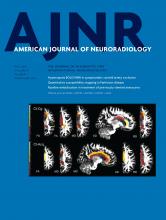Index by author
Silvera, V.M.
- Head and Neck ImagingYou have accessImaging Features of Juvenile Xanthogranuloma of the Pediatric Head and NeckD.T. Ginat, S.O. Vargas, V.M. Silvera, M.S. Volk, B.A. Degar and C.D. RobsonAmerican Journal of Neuroradiology May 2016, 37 (5) 910-916; DOI: https://doi.org/10.3174/ajnr.A4644
Sivan-hoffmann, R.
- NeurointerventionYou have accessEndovascular Treatment of Intracranial Aneurysms with the WEB Device: A Systematic Review of Clinical OutcomesX. Armoiry, F. Turjman, D.J. Hartmann, R. Sivan-Hoffmann, R. Riva, P.E. Labeyrie, G. Aulagner and B. GoryAmerican Journal of Neuroradiology May 2016, 37 (5) 868-872; DOI: https://doi.org/10.3174/ajnr.A4611
Slater, L.A.
- NeurointerventionYou have accessTICI and Age: What's the Score?L.A. Slater, J.M. Coutinho, J. Gralla, R.G. Nogueira, A. Bonafé, A. Dávalos, R. Jahan, E. Levy, B.J. Baxter, J.L. Saver and V.M. Pereira for the STAR and SWIFT investigatorsAmerican Journal of Neuroradiology May 2016, 37 (5) 838-843; DOI: https://doi.org/10.3174/ajnr.A4618
Smith, G.N.
- EDITOR'S CHOICEPediatric NeuroimagingOpen AccessBrain Structural and Vascular Anatomy Is Altered in Offspring of Pre-Eclamptic Pregnancies: A Pilot StudyM.T. Rätsep, A. Paolozza, A.F. Hickman, B. Maser, V.R. Kay, S. Mohammad, J. Pudwell, G.N. Smith, D. Brien, P.W. Stroman, M.A. Adams, J.N. Reynolds, B.A. Croy and N.D. ForkertAmerican Journal of Neuroradiology May 2016, 37 (5) 939-945; DOI: https://doi.org/10.3174/ajnr.A4640
The authors assessed the brain structural and vascular anatomy in 7- to 10-year-old offspring of pre-eclamptic pregnancies compared with matched controls (n=10 per group). TOF-MRA and a high-resolution anatomic T1-weighted MPRAGE sequence were acquired for each participant. Offspring of pre-eclamptic pregnancies exhibited enlarged brain regional volumes of the cerebellum, temporal lobe, brain stem, and right and left amygdalae. These offspring displayed reduced cerebral vessel radii in the occipital and parietal lobes. The authors conclude that these structural and vascular anomalies may underlie the cognitive deficits reported in the pre-eclamptic offspring population.
Smith, P.
- Pediatric NeuroimagingYou have accessNormal Development and Measurements of the Occipital Condyle-C1 Interval in Children and Young AdultsP. Smith, L.L. Linscott, S. Vadivelu, B. Zhang and J.L. LeachAmerican Journal of Neuroradiology May 2016, 37 (5) 952-957; DOI: https://doi.org/10.3174/ajnr.A4543
Sobczyk, O.
- ADULT BRAINYou have accessIdentifying Significant Changes in Cerebrovascular Reactivity to Carbon DioxideO. Sobczyk, A.P. Crawley, J. Poublanc, K. Sam, D.M. Mandell, D.J. Mikulis, J. Duffin and J.A. FisherAmerican Journal of Neuroradiology May 2016, 37 (5) 818-824; DOI: https://doi.org/10.3174/ajnr.A4679
Soh, C.
- EDITOR'S CHOICEADULT BRAINOpen AccessMitotic Activity in Glioblastoma Correlates with Estimated Extravascular Extracellular Space Derived from Dynamic Contrast-Enhanced MR ImagingS.J. Mills, D. du Plessis, P. Pal, G. Thompson, G. Buonacorrsi, C. Soh, G.J.M. Parker and A. JacksonAmerican Journal of Neuroradiology May 2016, 37 (5) 811-817; DOI: https://doi.org/10.3174/ajnr.A4623
Twenty-eight patients with newly presenting glioblastoma multiforme underwent preoperative conventional imaging and T1 dynamic contrast-enhanced MRI. Parametric maps of the initial area under the contrast agent concentration curve, contrast transfer coefficient, estimate of volume of the extravascular extracellular space, and estimate of blood plasma volume were generated, and the enhancing fraction was calculated. High values of the estimate of volume of the extravascular extracellular space were associated with a fibrillary histologic pattern and increased mitotic activity. This finding is counterintuitive to the standard concept that more proliferative tumors would be more densely packed with cells and have less extracellular space. As the authors point out, this surprising finding requires more investigation to understand whether this relationship will hold, and what the underlying mechanism might be.
Spliet, W.G.M.
- ADULT BRAINOpen AccessQuantitative Intracranial Atherosclerotic Plaque Characterization at 7T MRI: An Ex Vivo Study with Histologic ValidationA.A. Harteveld, N.P. Denswil, J.C.W. Siero, J.J.M. Zwanenburg, A. Vink, B. Pouran, W.G.M. Spliet, D.W.J. Klomp, P.R. Luijten, M.J. Daemen, J. Hendrikse and A.G. van der KolkAmerican Journal of Neuroradiology May 2016, 37 (5) 802-810; DOI: https://doi.org/10.3174/ajnr.A4628
Starke, R.M.
- FELLOWS' JOURNAL CLUBNeurointerventionYou have accessPipeline Embolization Device in the Treatment of Recurrent Previously Stented Cerebral AneurysmsB. Daou, R.M. Starke, N. Chalouhi, S. Tjoumakaris, D. Hasan, J. Khoury, R.H. Rosenwasser and P. JabbourAmerican Journal of Neuroradiology May 2016, 37 (5) 849-855; DOI: https://doi.org/10.3174/ajnr.A4613
Twenty-one patients with previously stented recurrent aneurysms who later underwent Pipeline Embolization Device placement (group 1) were retrospectively identified and compared with 63 patients who had treatment with the Pipeline with no prior stent placement (group 2). Pipeline treatment resulted in complete aneurysm occlusion in 55.6% of patients in group 1 versus 80.4% of patients in group 2. The retreatment rate in group 1 was 11.1% versus 7.1% in group 2. The authors conclude that the Pipeline is less effective in the management of previously stented aneurysms than when used in nonstented aneurysms.
Stellmann, J.-P.
- Spine Imaging and Spine Image-Guided InterventionsOpen AccessImproved Lesion Detection by Using Axial T2-Weighted MRI with Full Spinal Cord Coverage in Multiple SclerosisS. Galler, J.-P. Stellmann, K.L. Young, D. Kutzner, C. Heesen, J. Fiehler and S. SiemonsenAmerican Journal of Neuroradiology May 2016, 37 (5) 963-969; DOI: https://doi.org/10.3174/ajnr.A4638








